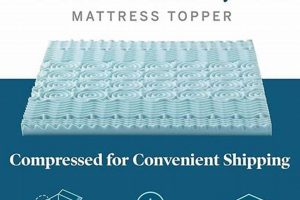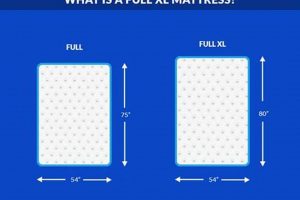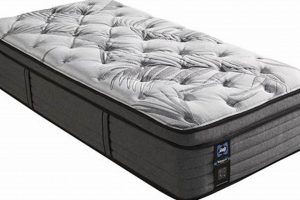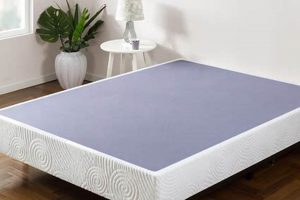A Full XL mattress is a bed size that combines the width of a standard full mattress with the length of a Twin XL. This results in dimensions that provide more legroom for taller individuals compared to a standard full-size bed. Specifically, its measurements are typically 54 inches in width and 80 inches in length.
The advantage of this dimension lies in its adaptability to smaller spaces while still accommodating a taller sleeper. Historically, standard full-size beds were often too short for adults, leading to discomfort. This mattress size offers a solution by maintaining a relatively compact width while adding necessary length.
Therefore, understanding the measurements of a Full XL mattress is crucial when making informed decisions regarding bedroom furniture and comfort preferences. The subsequent sections will delve into its practical applications and suitability for various individuals and room sizes.
Understanding the Dimensions of a Full XL Mattress
When selecting a Full XL mattress, it is essential to consider factors beyond its basic dimensions. Several practical tips can ensure the chosen mattress is a suitable fit for individual needs and bedroom spaces.
Tip 1: Measure the Intended Space. Accurately measure the bedroom to confirm that the 54-inch by 80-inch footprint of the Full XL mattress will fit comfortably, allowing for adequate walking space and placement of other furniture.
Tip 2: Assess Sleeper Height. The 80-inch length is designed for taller individuals. Evaluate whether the sleeper’s height necessitates this additional length to avoid discomfort from feet hanging off the bed.
Tip 3: Consider Room Sharing. While wider than a Twin XL, a Full XL might still be too narrow for two adults to sleep comfortably. Assess whether the 54-inch width provides sufficient personal space for both individuals.
Tip 4: Evaluate Bedding Availability. Ensure that bedding, such as sheets and comforters, is readily available in Full XL sizes, as standard full-size bedding will be too small for the extended length.
Tip 5: Check Frame Compatibility. Verify that the existing bed frame or platform is designed to support the dimensions of a Full XL mattress. Using an improperly sized frame can damage the mattress or compromise support.
Tip 6: Consider Weight Distribution. When used by a single sleeper, the Full XL provides ample space. However, when shared, ensure the mattress is designed to distribute weight evenly to prevent sagging or discomfort.
These considerations highlight the importance of careful planning before purchasing a Full XL mattress. By focusing on these tips, individuals can confidently select a mattress that maximizes comfort and optimizes space.
The subsequent sections will address the comparative advantages and disadvantages of this mattress size in different scenarios, further assisting in making an informed decision.
1. 54 inches wide
The “54 inches wide” dimension is a defining characteristic of what constitutes a Full XL mattress. It directly dictates the available sleeping surface in terms of width. This measurement is the standardized width inherited from the standard full-size mattress. The direct impact is on the comfort level for the individual sleeper, especially if they tend to move around during sleep. A wider mattress generally offers more freedom of movement without the risk of rolling off the edge. In shared sleeping situations, “54 inches wide” translates to less personal space per individual compared to wider mattress sizes such as queen or king.
The practical significance of understanding the “54 inches wide” dimension is evident in space planning and purchase decisions. For instance, a bedroom with limited floor space might be able to accommodate a Full XL due to its width being less than a queen, while still offering adequate length for a taller person. Furthermore, the “54 inches wide” parameter influences the cost and availability of bedding. Bedding specifically designed for this width is generally more available and affordable than that for larger sizes, but less widely available than standard full bedding due to the XL length.
In conclusion, the “54 inches wide” parameter is an integral component defining the Full XL mattress and understanding its implications is critical for informed decision-making. This specific width dictates the suitability of the mattress in terms of space constraints, comfort for the sleeper, and bedding options. Challenges may arise in shared sleeping situations due to limited individual space, underscoring the importance of evaluating needs carefully before purchase.
2. 80 inches long
The “80 inches long” dimension is a critical element defining the overall size and purpose of a Full XL mattress. It represents the extended length characteristic that differentiates it from a standard full-size mattress. This added length directly addresses the needs of taller individuals, preventing discomfort caused by insufficient legroom. The “80 inches long” dimension ensures that a sleeper of average to above-average height can fully stretch out without their feet extending beyond the mattress edge. Without this specific length, the mattress would revert to a standard full size, negating its intended benefit for taller users.
Consider the example of an individual who is 6’2″ (74 inches) tall. A standard full-size mattress, typically 75 inches long, would leave only a few inches of leeway. With bedding and pillow usage, this person’s feet would likely hang off the edge, leading to disrupted sleep. The “80 inches long” Full XL provides a crucial five additional inches, significantly improving sleep comfort. In practical applications, understanding this dimension allows consumers to make informed decisions based on their height requirements, optimizing their sleep experience and preventing potential health issues related to sleep deprivation.
In conclusion, the “80 inches long” measurement is indispensable to the definition and functionality of a Full XL mattress. It directly influences user comfort, especially for taller individuals, and represents a significant advantage over standard full-size options. Recognizing the practical implications of this dimension enables consumers to select a mattress that adequately meets their needs, promoting better sleep quality and overall well-being. Challenges may arise if the mattress frame is not properly sized to accommodate this extra length, underscoring the importance of considering all components of the bed system.
3. Increased legroom
Increased legroom is a primary benefit derived from the specific dimensions of a Full XL mattress. This feature is directly related to the extended length, which distinguishes it from standard full-size options, thereby catering to the needs of taller individuals.
- Accommodation of Taller Individuals
The extended length of a Full XL mattress, typically 80 inches, directly provides increased legroom. This is particularly relevant for individuals exceeding average height who often find standard full-size mattresses, usually 75 inches long, inadequate. The additional 5 inches allows for comfortable extension without the discomfort of feet hanging off the edge, promoting better sleep posture.
- Enhanced Sleep Comfort and Quality
Adequate legroom significantly impacts sleep quality. Discomfort due to cramped sleeping conditions can lead to restless nights and disrupted sleep cycles. By providing sufficient space for the entire body, the Full XL mattress minimizes these disturbances, contributing to more restful and restorative sleep.
- Prevention of Physical Discomfort
Consistent lack of legroom during sleep can lead to physical discomfort and potential health issues. Constricting the natural sleeping position can strain muscles and joints, resulting in aches, pains, and even long-term postural problems. Increased legroom mitigates these risks, promoting healthier sleep habits.
- Optimized Use of Bedroom Space
The dimensions of a Full XL mattress strike a balance between accommodating taller sleepers and efficiently utilizing bedroom space. While longer than a standard full, it maintains a manageable width, making it a practical choice for smaller bedrooms where a queen or king-size mattress may not be feasible. This allows for increased legroom without sacrificing valuable floor space.
Therefore, the increased legroom afforded by a Full XL mattress is a direct consequence of its specific dimensions, significantly improving the sleep experience for taller individuals. It addresses a common issue of discomfort and restricted movement, promoting better sleep quality and minimizing potential health risks associated with inadequate sleeping space. This feature is a key factor in selecting a Full XL mattress, particularly when considering individual height and bedroom size constraints.
4. Single sleeper comfort
The association between single-sleeper comfort and the dimensions of a Full XL mattress is significant. The dimensions, specifically the 54-inch width and 80-inch length, directly influence the individual’s sleep experience. The extended length, compared to a standard full, provides ample legroom for taller individuals, preventing discomfort and promoting restful sleep. The width offers adequate space for movement during sleep without feeling confined. Therefore, the size characteristics contribute to enhanced comfort for a single sleeper.
Consider an individual transitioning from a Twin XL mattress to a Full XL. The increased width offers additional freedom of movement, reducing the likelihood of waking due to space limitations. This is particularly beneficial for sleepers who change positions frequently during the night. Furthermore, the consistent support across the mattress, designed for a single occupant, ensures uniform weight distribution and minimizes the risk of sagging, thereby extending mattress lifespan and maintaining comfort levels over time. A practical application includes scenarios where individuals prioritize space and comfort over sharing the bed; the Full XL offers a compromise between a compact footprint and enhanced personal space.
In summary, single-sleeper comfort is a key consideration when evaluating the dimensions of a Full XL mattress. The extended length and sufficient width provide a balance between space efficiency and sleep quality. Challenges may arise if an individual requires significantly more sleeping space, necessitating a larger size like a queen or king. However, for single sleepers seeking a comfortable and accommodating mattress within a limited space, the Full XL presents a viable solution.
5. Compact width
The characteristic compact width is an integral component defining a Full XL mattress. This dimension significantly impacts its suitability for various room sizes and sleeping arrangements.
- Space Optimization in Smaller Rooms
The 54-inch width of a Full XL mattress allows for effective space utilization in smaller bedrooms or apartments. Unlike queen or king-size mattresses, its reduced width leaves more floor space, enabling easier movement and accommodation of other furniture. This is particularly relevant in urban living environments where space is often a premium.
- Suitability for Single Sleepers
The compact width is well-suited for single sleepers who desire more space than a twin mattress but do not require the expanse of a queen or king. The 54-inch dimension provides sufficient room for comfortable movement during sleep without feeling confined, addressing the needs of individuals who prioritize personal space.
- Comparison to Other Mattress Sizes
In contrast to a standard full mattress, a Full XL maintains the same width while offering extended length. When compared to a queen-size mattress, which typically measures 60 inches wide, the Full XL provides a narrower profile. This dimensional difference can be a deciding factor when selecting a mattress based on room size constraints and individual sleeping preferences.
- Implications for Bed Frame Selection
The compact width of a Full XL mattress influences the choice of bed frames and foundations. It necessitates the use of a frame specifically designed for this size, ensuring proper support and stability. Standard full-size frames may not adequately accommodate the extended length, and larger frames would result in an ill-fitting mattress, underscoring the importance of precise dimension matching.
In summary, the compact width is a key aspect defining a Full XL mattress. It facilitates space optimization in smaller rooms, caters to single sleepers’ preferences, and influences bed frame selection. Understanding the implications of this dimension is crucial for consumers seeking to balance comfort, space efficiency, and practicality in their mattress choice.
6. Bedding compatibility
Bedding compatibility is a crucial consideration directly influenced by the specific dimensions defining a Full XL mattress. The 54-inch width and 80-inch length necessitate correspondingly sized bedding. Standard full-size bedding, typically designed for a 75-inch length, will be insufficient, leaving a gap at the foot of the bed and compromising comfort. Conversely, queen-size bedding, while accommodating the length, will be too wide, resulting in excess fabric and a potentially ill-fitting aesthetic. Therefore, the specialized dimensions dictate the need for bedding explicitly labeled as “Full XL” to ensure proper fit and functionality. Failure to adhere to this requirement can lead to discomfort, aesthetic inconsistencies, and reduced lifespan of the bedding.
Consider the scenario of purchasing standard full-size sheets for a Full XL mattress. The shorter length of the fitted sheet would prevent it from fully enveloping the mattress, causing it to slip off during sleep. This not only disrupts sleep but also accelerates wear and tear on both the sheet and the mattress. Similarly, a comforter designed for a full-size bed would leave the lower portion of the mattress exposed, potentially leading to uneven temperature regulation during sleep. Bedding manufacturers recognize this dimensional variance and offer dedicated Full XL bedding sets, addressing the specific needs of this mattress size. These sets ensure a snug fit, optimizing comfort and aesthetic appeal.
In summary, bedding compatibility is inextricably linked to the dimensions defining a Full XL mattress. The unique length mandates specialized bedding, ensuring optimal fit and performance. Challenges may arise from the limited availability of Full XL bedding compared to standard sizes, requiring consumers to seek out specific retailers or online vendors. However, the benefits of proper bedding compatibility, including enhanced comfort and extended product lifespan, underscore its importance in the overall sleep experience. The understanding of this relationship is essential for informed purchase decisions and maximizing the utility of a Full XL mattress.
7. Frame requirements
The dimensional specifications defining a Full XL mattress directly dictate the necessary frame requirements. A properly sized and supportive frame is essential for ensuring the mattress’s longevity, comfort, and overall functionality. Inadequate or improperly sized frames can lead to mattress damage, compromised support, and a diminished sleep experience.
- Dimensional Accuracy
A Full XL mattress frame must accurately match the mattress’s dimensions, which are 54 inches in width and 80 inches in length. A frame that is too small will not fully support the mattress, leading to sagging and uneven weight distribution. Conversely, a frame that is too large will allow the mattress to shift and slide, potentially causing discomfort and instability. Exact dimensional alignment is crucial for optimal support and mattress performance.
- Load-Bearing Capacity
The frame must possess adequate load-bearing capacity to support the weight of the mattress and its occupants. Full XL mattresses, particularly those made with heavier materials such as memory foam or latex, can be substantial in weight. A frame lacking sufficient strength may buckle or break under the combined weight, resulting in damage to both the frame and the mattress. Proper evaluation of the frame’s weight rating is essential for ensuring long-term durability.
- Support Structure
The support structure of the frame, whether it consists of slats, a solid platform, or a box spring, plays a critical role in maintaining the mattress’s shape and preventing sagging. Slats should be closely spaced to provide uniform support across the entire surface. A solid platform offers continuous support, while a box spring acts as a shock absorber and distributes weight evenly. The choice of support structure should complement the mattress type and address specific support needs.
- Material Durability
The materials used in the construction of the frame should be durable and resistant to wear and tear. Common frame materials include wood, metal, and composite materials. Wood frames offer a classic aesthetic and can provide excellent support, but may be susceptible to warping or cracking over time. Metal frames are typically more durable and resistant to damage. The selection of frame materials should consider both aesthetic preferences and long-term durability requirements.
Ultimately, understanding the frame requirements for a Full XL mattress is paramount for maximizing its lifespan, comfort, and support. Adherence to dimensional accuracy, load-bearing capacity, support structure, and material durability guidelines will ensure that the mattress performs optimally and provides a restful sleep experience. Failure to consider these factors can lead to premature mattress wear, discomfort, and potential safety hazards.
Frequently Asked Questions
This section addresses common inquiries regarding the dimensions and practical applications of a Full XL mattress.
Question 1: What are the precise measurements of a Full XL mattress?
A Full XL mattress measures 54 inches in width and 80 inches in length. These dimensions distinguish it from a standard full-size mattress, which is shorter in length.
Question 2: Why is the length of a Full XL mattress significant?
The 80-inch length provides additional legroom, making it suitable for taller individuals who may find a standard full-size mattress too short. This added length enhances sleep comfort and prevents discomfort.
Question 3: Is a Full XL mattress appropriate for two sleepers?
While a Full XL mattress can accommodate two sleepers, its 54-inch width may provide limited personal space for each individual. It is generally more suitable for single sleepers or couples who prefer close proximity.
Question 4: Is specialized bedding required for a Full XL mattress?
Yes, bedding specifically designed for Full XL mattresses is necessary to ensure a proper fit. Standard full-size bedding will be too short, while queen-size bedding will be too wide. Full XL bedding sets are readily available from various retailers.
Question 5: What type of bed frame is needed for a Full XL mattress?
A bed frame designed to support the dimensions of a Full XL mattress is required. The frame should accurately match the mattress’s width and length to provide adequate support and prevent sagging. Universal bed frames or adjustable frames may also be compatible.
Question 6: How does the cost of a Full XL mattress compare to other sizes?
The cost of a Full XL mattress typically falls between that of a standard full-size mattress and a queen-size mattress. Pricing can vary depending on the materials used, brand, and retailer.
Understanding these frequently asked questions provides clarity regarding the Full XL mattress dimensions and its practical implications.
The subsequent section will offer a comprehensive comparison of the Full XL mattress to other mattress sizes, further aiding in informed decision-making.
Understanding the Full XL Mattress Dimensions
The foregoing discussion has meticulously explored the defining characteristics of a Full XL mattress. Specifically, the measurements of 54 inches in width and 80 inches in length are paramount. These dimensions influence not only the comfort and support offered, but also the practical considerations of space utilization, bedding compatibility, and appropriate frame selection. The extended length, a key differentiator from standard full-size mattresses, caters directly to the needs of taller individuals, preventing discomfort and promoting improved sleep quality. The compact width ensures the mattress remains a viable option for smaller bedrooms where larger sizes may not be feasible.
Therefore, understanding the size attributes of a Full XL mattress is crucial for making informed purchasing decisions. Considerations such as individual height, room size constraints, and availability of appropriately sized bedding should all be carefully evaluated. Continued advancements in mattress technology and design may further refine the Full XL’s attributes, offering enhanced comfort and support features. A thorough awareness of these dimensional specifications empowers consumers to select a mattress that optimally addresses their individual needs, ultimately contributing to a more restful and restorative sleep experience.







